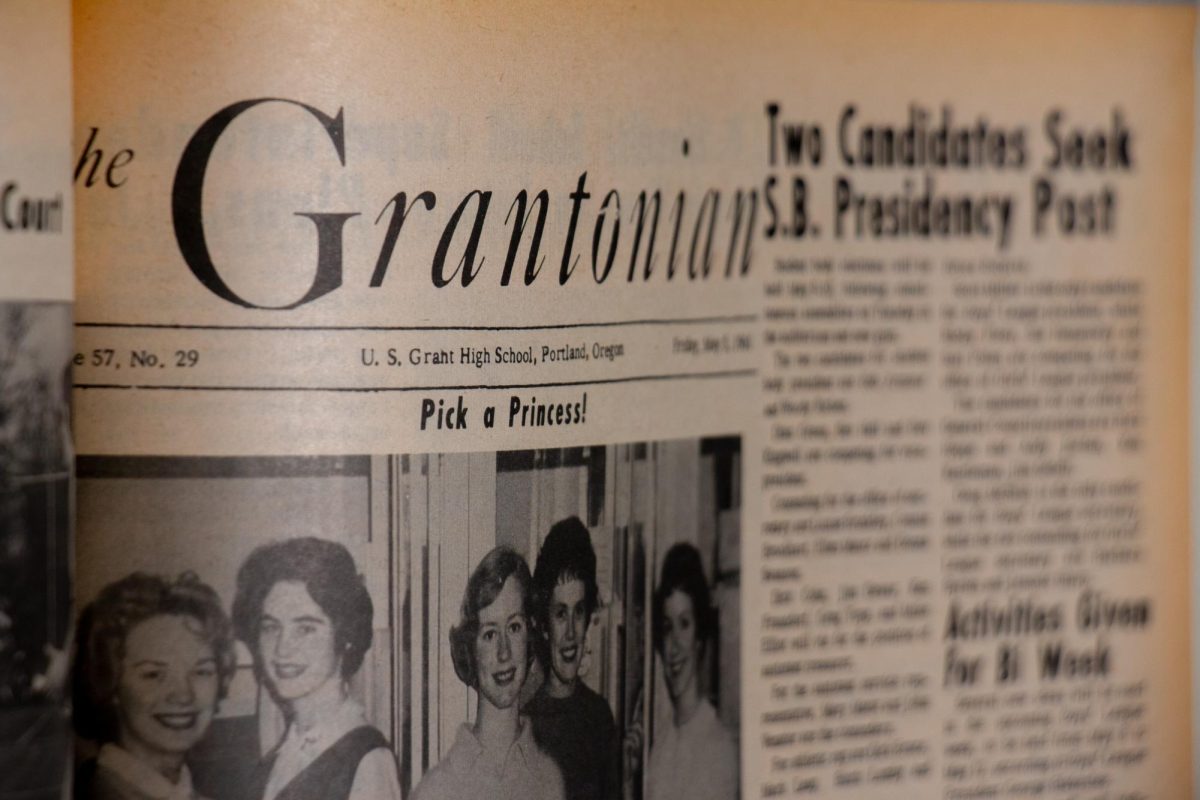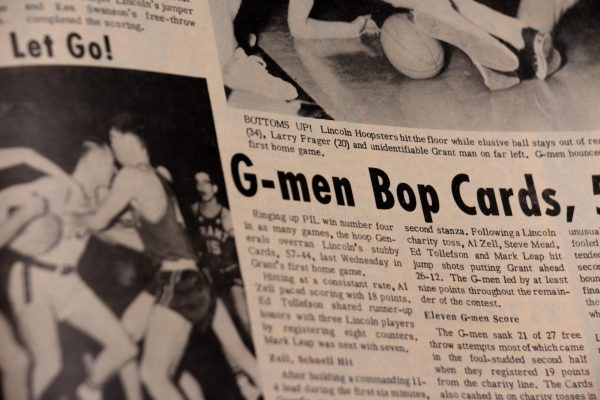
Matt Polk
The Grantonian covers the annual rose princess voting ceremony in a 1961 issue to be handed out to the entire school.
Before Grant Magazine’s founding in 2011, the journalistic publication that served the Grant High School community was a four-page weekly newspaper titled The Grantonian. Created shortly after the school’s opening in 1924, the publication is remembered today in the name of Grant’s digital newsletter.
Student journalism was in full force in Grant’s early years, especially in a period from 1958-1961: The Grantonian was producing weekly papers with profiles of “Generals of the Week,” student council news, sports reviews coined “Bench Warmings” and “Kampus Kapers” — a recurring section which reported the goings on of the Grant community. One issue featured a “Letter to the Editor” in which former Grant principal Harold Kleiner wrote, “I was pleased to read in the Grantonian of April 11 that the students of Grant High School have improved their traffic violation record.” A well-established newspaper, The Grantonian even promoted advertisements from businesses such as Chin’s Kitchen, a restaurant that is open to this day.
Janet Goetze, Susan Pryor, Beatrice (Bea) Krauss and Cathy Castillo are four Grantonian alumni who were part of what they call a “clique” at Grant. As they helped create the weekly Grantonians along with the rest of the staff, they would simultaneously foster a lifelong friendship. “There was a mischievous teenage side to us, but we were trying to do the right thing. We really were. We were trying to make it an excellent newspaper. Sometimes we messed up and we were varied, and so we learned things from one another,” says Krauss, who spent her junior and senior years on The Grantonian as a reporter and feature writer.
With a strong interest in writing, Krauss was advised to join The Grantonian by her English teacher. After being recommended by the newspaper’s advisor to attend a summer journalism program at Northwestern University, Krauss went on to attend the university with the intent of majoring in journalism. But the lack of writing in the first year of the program would lead her to switch majors, instead choosing a music major to play the harp. However, after taking an introductory social psychology class with a well-known social psychologist at the university, Krauss would go on to pursue the field and later earn a Ph.D. in Social-Personality, involving herself in over 40 research projects focused on familial and community responses to health threats and publishing a book of poetry called “Strong Medicine.”
Though she did not become a journalist, Krauss’ time on the newspaper still proved useful: It taught her how to write a good hook. “I learned … the ‘V’ about writing, how you put the most important things first and then taper on down so that you really catch the reader,” she says. “That has stood me in very good stead my entire life, because I’m a health psychologist … I got grants when nobody else could get grants, because I started off with something that would catch the reviewers who were sitting there reading boring grant proposal after grant proposal after grant proposal.”
Similarly, while Pryor did not choose to pursue journalism as a career, she would still use her learned writing skills later in her professional life. Pryor worked on The Grantonian throughout her junior and senior years, managing its advertisements, distribution and exchanges with other high schools.
“We didn’t have that many ads, and I had to fight for space with the guys who ran the sports page,” says Pryor, recounting the experience of reaching out to businesses in the Hollywood district. “It was such a different place than it is right now. It had everything … we had ads from the florists and the photographers and bakery and little things like that … Life in the ‘50s was a whole lot different.”

Pryor moved back to Portland just over 10 years ago, after living in San Rafael, California for nearly 50 years.
Goetze and Castillo, however, would pursue journalism after their time on The Grantonian, and went on to have successful careers in the field.
Goetze, who was on the Grantonian during her senior year, from 1959-1960, was assigned to be a copy editor and a reporter for the spring semester. In the newspaper, Goetze recounts getting in trouble with the principal over a scandalous story. “We ran a letter to the editor that was critical of the school administration, but it was unsigned … people felt, ‘Well, we should run the letter anyway.’ And apparently some people on the school board and other things questioned that happening, so I had to go see the principal, who, at that time, was Harold Kleiner. My impression was that he was suppressing a smile as I came in.”
Goetze attended University of Oregon and, inspired by her time on the Grantonian, worked on its publication: The Daily Emerald. After briefly living in New York City working for a magazine, she went to work for Associated Press (AP) in Los Angeles in 1965 during the Watts Riots. Goetze briefly worked in Louisville, Kentucky, before moving back to Oregon to work first at Eugene’s The Register-Guard and then later as a freelance reporter for The Oregonian. While at The Oregonian, she covered multiple beats, from land use and the environment to Washington and Clackamas county.
Goetze got involved in freelance journalism again after retiring from The Oregonian, covering East Multnomah County schools in Portland. Up until last year, Goetze worked for The Hollywood Star News, majorly reporting on local schools.
Castillo’s journalism career began similarly: After being an editor for The Grantonian her senior year, she attended the University of Oregon and worked on The Daily Emerald as a reporter and editor.
After college she began working as a reporter for The Register-Guard, but was then chosen for an internship at AP in Portland during a presidential election. Later, AP would hire her as a reporter in Seattle, Washington, where she covered “everything except sports.” After getting married, she and her husband moved to San Jose, California, where she worked for San Jose’s The Mercury News and then later the San Francisco Chronicle.
From her career in daily journalism, Castillo thinks most highly of her stories covering the Patty Hearst kidnapping in 1974 and the group of women who were the first Americans to climb Annapurna in 1978.
However, Castillo’s favorite beat to report on was education. “Covering criminal courts could be entertaining … but probably the one I liked best was covering K-12 education. I just thought it was something that was really useful to readers and that readers really cared about,” she says. “The San Jose area has dozens of school districts, some of them are little, tiny ones, and one of those produced some of the most interesting stuff.”
Despite these women’s winding paths, most managed to stay in close contact with one another throughout their lives. They exchanged letters, vacationed together and met up for special events. “Even after years, when you’ve been with people who you care about, you get together. You haven’t seen them in five years or something, and suddenly it doesn’t matter,” says Pryor. “They’re the same and you’re the same and you just pick up where you left off.”
Many of these women credit their enduring bonds and passions for journalism to Alvin Alexandre, The Grantonian’s advisor at the time. “Mr. Alexandre had our schedules set up so that we had fifth period lunch, sixth period journalism class (and) seventh period study hall in the same room. So essentially, we would spend the year, if we wanted to, with three periods together a day, five days a week,” says Pryor. “You can imagine that kind of bonding that happened, which is why you end up with these old ladies who’ve known each other for 65 years.”
Even after graduating high school, many of these women kept in contact with Alexandre, remaining close friends with his family. “He would encourage us that we were going to be good at it, whether it meant working on The Grantonian or going on and doing something else later. He was enthusiastic,” says Castillo. Alexandre was regarded so highly that in one Grantonian issue, he was even the subject of his own profile, which wrote “Teaching is a great satisfaction to Mr. Alexandre. He enjoys talking with teenagers and has helped a number of them. Students are eager to learn and desirous to turn out a good paper for a man who is such an example of top rate quality.”
During the COVID-19 pandemic, when most were stuck inside their homes, Krauss decided to turn the group’s infrequent meetings into a regular event. “I became a widow in 2016, and COVID hit in 2020, and I had been playing harp at hospice … I knew isolation in older age is not good for your health, so I came up with the idea that during COVID, we would have this Tuesday tea.” Krauss set up a weekly meeting on Zoom where these women, many of whom lived in different parts of the country, could virtually meet and talk. The group now extends beyond the initial four: Many of the “Tuesday tea” members are friends of friends or Grant alumni who were not on The Grantonian.
After multiple years of Tuesday teas, the group continues to meet weekly. Today, many of their conversations surround politics, movies, books and travel. “We made friendship around (The Grantonian), and, of course, then having subsequent events, our relationship is now is more than The Grantonian,” says Goetze.
Even though their initial bonds were forged by The Grantonian, it was this connection that made their friendships last. “It’s just kind of wonderful, after all these years to see how … we did pretty well. We’re all in a pretty good place, and it’s nice to see that. It’s wonderful to have friendships that last this long, and they were very casual. It wasn’t like we were in business together, or we had to see one another — it was that we were friends. And that’s very valuable.”